She was there when the O.J. Simpson verdict came in. She saw Lindsay Lohan escorted out of the courtroom in handcuffs and Louboutins. Mobster Whitey Bulger once stared her down and wagged his finger at her.
Mona Shafer Edwards, an LA-based artist, has been sketching courtroom drama for decades. Her illustrations have accompanied reporting on some of the country’s most famous cases, from those involving celebrities like Lohan, Britney Spears, and the Kardashians to the criminal murder trials of Simpson, Bulger, “Night Stalker” Richard Ramirez, and “Grim Sleeper” Lonnie David Franklin Jr.
While some high-profile cases get the “gavel-to-gavel coverage,” many judges do not allow proceedings to be broadcast — or even photographed.
That’s where courtroom sketch artists like Edwards come in. And often, they have only moments to capture an emotional reaction, bombshell testimony, or other nuances of the proceedings.
I met Edwards briefly when I was covering the Robert Durst murder trial in LA and have always been curious about her work. Last week, she put her sketch pad down long enough to answer some of my most burning questions. (This interview has been lightly edited and condensed for clarity.)
Yours is such a fascinating career. How did it start?
It's very bizarre, and it was kind of happenstance.
I was a very busy fashion artist. But it was boring, because how different can one pantsuit be from another, or a summer frock or whatever? There's more to life than that.
I love news — I've always been a newshound. And one evening [in the ’70s], I was watching the news and saw some terrible drawings. And I said to my husband, “I can do that.”
As soon as I started doing courtroom art, it just hooked me. I just fell in love with it because it's fast, and I'm very fast. It's different all the time. It's history. It's current events. It's everything I love. Sometimes it's very, very sad and scary. Sometimes when justice really is served, it's very uplifting. So it's like all of the emotions that run through that make it so unique and exciting.
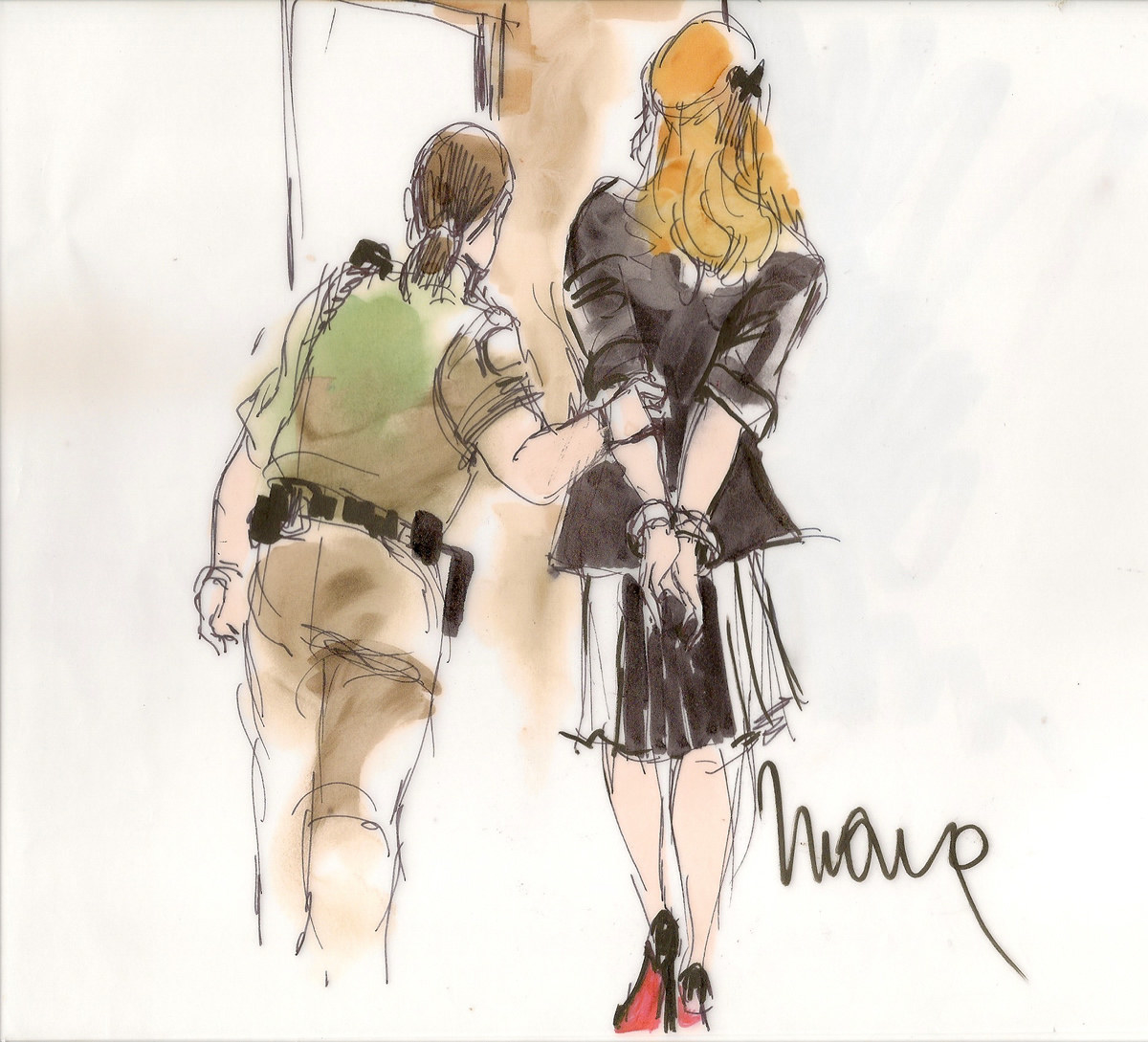
How can you capture someone's essence so quickly and accurately?
I take a mental photograph. I take a breath and I look around the room. I take a beat, a count. I have these little mental photographs, like a little click in my head that goes from top to bottom. And I look at the person, and I just feel…their soul. It sounds corny, but it's true. I see their body language, I see the way they sit, the way they’re dressed. … You can surmise a lot about somebody by the way they move, the way they sit, their expressions. And I just try and take that in before I even put the pen to the paper. And many times I already have the drawing in my head before I put the pen to the paper.
Tell me about some of the emotions you go through while you’re covering really difficult cases.
There are some moments that are like, oh my god, my heart is beating. The Hawks murder was one of the worst: It was this couple that were duct-taped and thrown over their boat with the anchor. And the testimony was that you could see the fingernail marks on the deck as they were being dragged. There are details that are so horrific. Before the verdict, a reporter and I were holding hands, we were so nervous. [Their killers were all found guilty, with one being sentenced to death.]
7 Murder Cases Where A Body Was Never Found
I know you’re currently working on the Anthony Avalos murder trial, in which a woman and her boyfriend have been charged with torturing and killing her 10-year-old son. How do you personally deal with the trauma of sitting in the courtroom through so many tragic cases like this?
I have to sit there and I have to keep a straight face. You know, instead of wanting to jump over into the well there and, like, strangle someone. I hold it together because I've been doing this a really long time. There was one time that I had to run out of a courtroom … I was almost sick. But that was a long time ago. I divorce myself from what's going on at the moment. And I just draw and I can't think about it. But when it's over and I'm driving home, it all just kind of comes out. And then I go over it, I ruminate. I just think about it over and over and over. So sometimes these trials don't leave me for a very long time. I think about them all the time. I think about victims all the time. And I think about justice for victims.
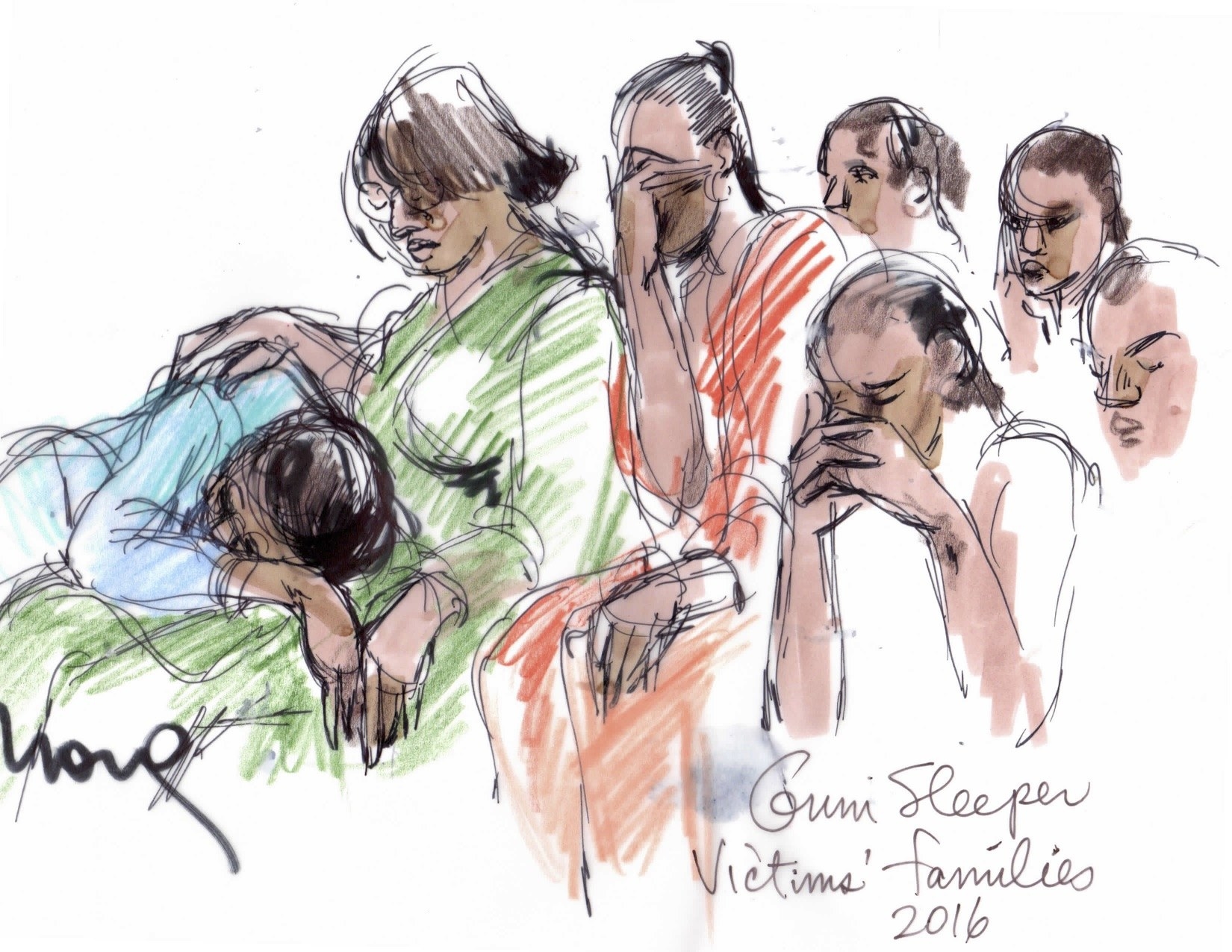
One of your most striking pictures is of a victim’s family reacting to a verdict.
It was the Grim Sleeper case, and it was the families of these unknown women. And the families finally after [decades] finally got justice, and they just let loose, crying and wailing and flinging themselves and stuff like that … it's very moving.
You mentioned being scared in a courtroom. Is there anyone in particular who frightened you the most?
Whitey Bulger. He was sitting behind glass. I was sketching him and he looked at me, and he pointed at me and wagged his finger, like, “Do not draw me.” [Even though] there's all these marshals all around and there's glass between us, the way he looked at me, I got scared. Sometimes I'm a little bit nervous, but then I'm thinking, Wait a minute. I just draw the picture. I don't have any involvement in anything. I've been afraid. Richard Ramirez, the “Night Stalker,” was staring at me. He looked at me and that was scary. I mean, at the time, all of Southern California was terrified of this guy.
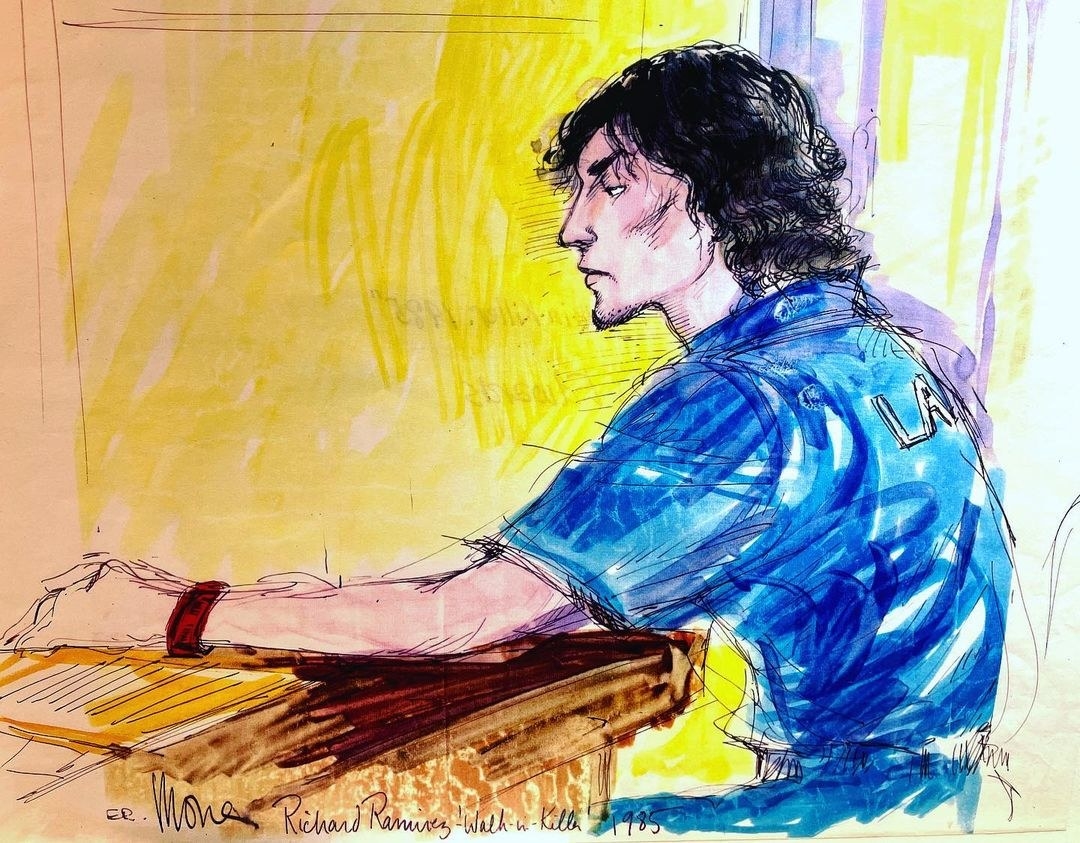
Who was the most challenging person or people for you to draw?
I will say the two that were the most difficult to draw are Elon Musk and Alec Baldwin. It was the most frustrating thing because their faces changed with each quarter inch that they moved. It was so difficult to draw them, maybe because there was no evident landmark on their face. Somebody like Clint Eastwood is easy to draw: You've got the eyebrows. You have this aquiline nose. You've got cheekbones.
It was really difficult to draw the Kardashians too [in the Blac Chyna case]. Because if you saw them on the street, you didn't know who they were. And I know that the Kardashians do not release any pictures unless they have been OK’d by their team. It's been photographed, photoshopped, and filtered — you name it. All the Kardashians came in and I was thinking, You got to be kidding. They don’t look anything like you see on the internet.
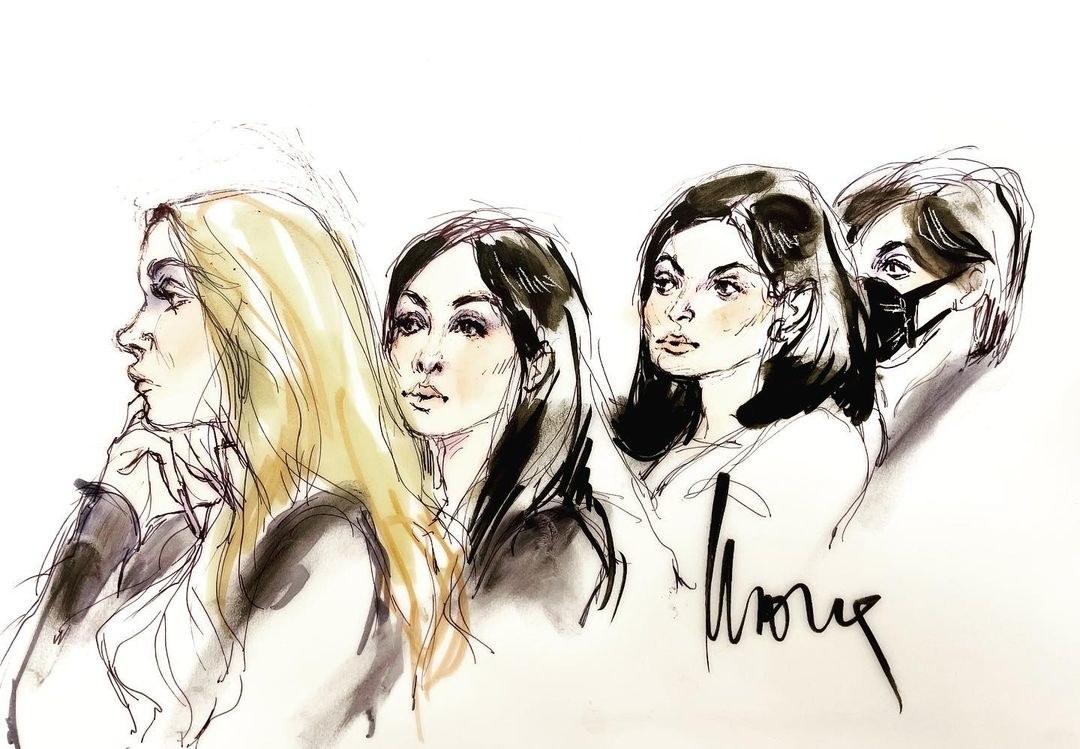
I got slammed by the fans. You know, like, “Who is this artist? You need to fire this artist.” And then as the trial went on every couple of days or so — you know, it's like when I get to know a person and when I'm drawing them more than just one day, you get a different kind of feeling about them. So when I do a trial, my drawings on the first day are not the same as the drawings on the fifth day. Any more time with them? Yeah. So what happened was the Daily Mail did a story saying the Kardashian artists must have been paid privately by the Kardashians to draw them better.
Do you take this stuff to heart or does it just wash off your back?
I get so many of these kinds of comments. It's better not to read the stuff. Some of it is really scary and not very nice. I got the same sort of treatment on the Megan Thee Stallion case, with Tory Lanez. I was in a real tight rush to make a tight deadline. I was drawing Megan and I was drawing her former friend [Kelsey Harris]. Those drawings were all really good. I mean, really good. I got them but I forgot to fill in the rest of Tory Lanez’s hair. I just did an indication with a couple lines. Oh my goodness, I got like 100 comments. “What did she do to Tory Lanez? She drew him like he's wearing a toupee or something.” I was like, oh please, give me a break.
People take their celebrities very seriously. That's why it's easier to draw people who nobody knows.
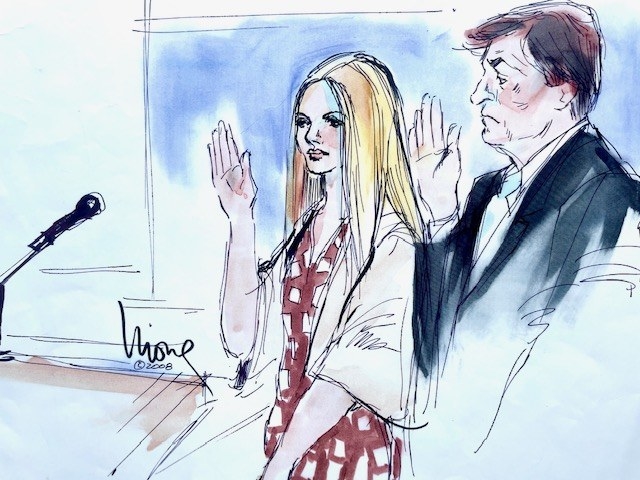
Is there a particular celebrity that stood out to you the most?
Oh yes. I've been drawing Britney Spears since the ’90s, when all I wanted to do was take her home and take care of her. I looked at her and I just was so sad for her because my daughter is approximately the same age.
I'm struck by the regular people — the people you don't know their names because they're not famous — and struck by what people go through. And we don't know anything about them, you know, you do like a sentence in the newspaper. Those are the cases I care about. Children's stuff I care about.
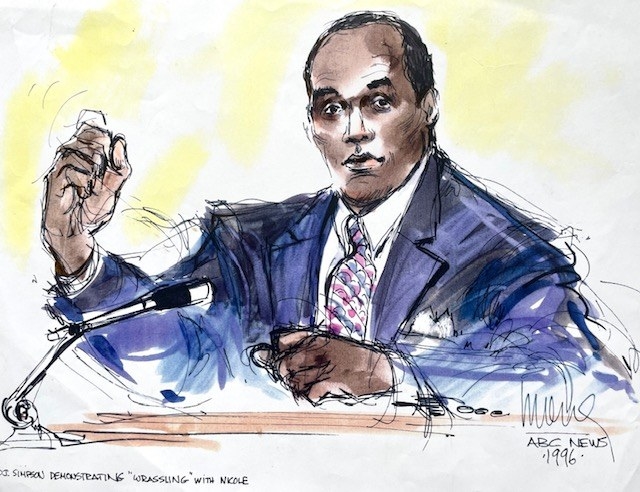
Can you remember a gaspworthy moment, something that just really shocked you?
The O.J. verdict. I was there. I can’t say anything more than it was gaspworthy. I'm not gonna say whether I agreed or I didn't agree, but it was a shock. I was on the media floor, next to the family, on the 12th floor. There was total silence in the room. And then there were screams — screams of jubilation. And then the rest of the people were just silent. And went about just writing their stories. It was the biggest divide I had ever, ever seen on a verdict.
You can see more of Edwards’s art — from courtroom sketches to fashion illustrations and more — on her website, monaedwards.com.

Don't forget to subscribe to our true crime newsletter, Suspicious Circumstances, to get true crime deep dives delivered straight to your inbox every week. Sign up here.
